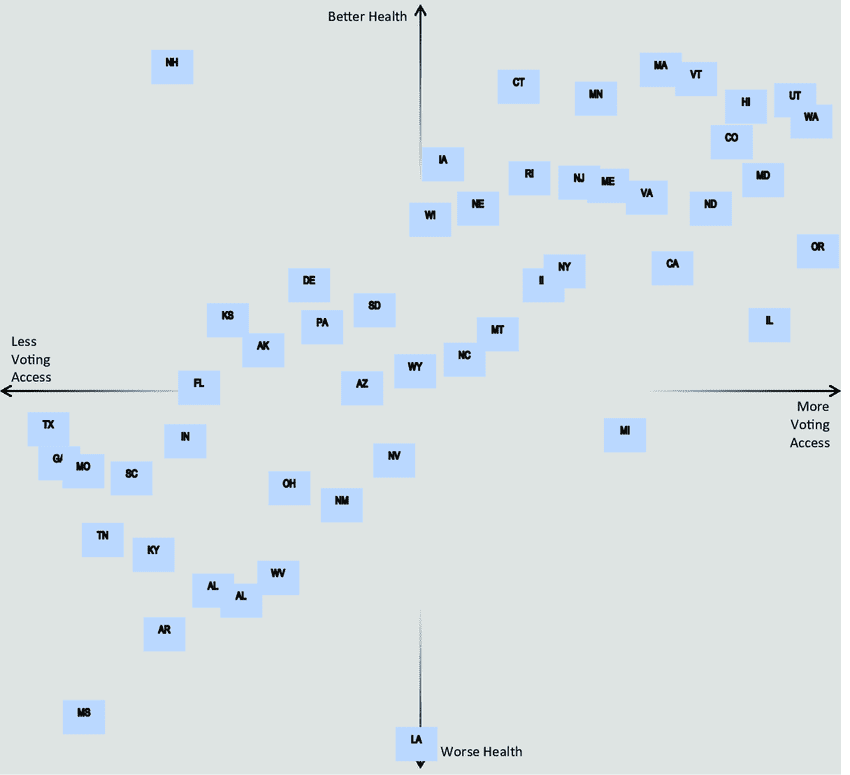This blog is part of a series written by FSG leaders on inclusive democracy and civic engagement. Read the full series here.
The health of a democracy doesn’t just determine elections—it determines our physical and mental health too. While few health foundations focus on civic engagement, the links between civic participation and health outcomes are clear: people are healthier in places that have more inclusive voting policies. In the countdown to the November U.S. elections, health funders have an opportunity to advance health equity through supporting voter engagement and civic participation.
The Linkages Between Health and Voting
Voting is an act of civic engagement and a proxy indicator for other forms of civic participation. Research suggests that voting is good for our health in two ways:
1. Voting is a means to an end: When people vote, they can elect leaders and support ballot initiatives that support health-promoting policies like Medicaid expansion, public green spaces, or regulation of environmental toxins. This year’s presidential election, for example, will have implications for reproductive health for women, insurance coverage, and drug prices.
2. Voting is an end itself: Voting is associated with positive increases in mental health, which also supports physical health. A longitudinal study published in 2019 showed linkages between civic engagement activities (e.g., voting and volunteering) and a decrease in depressive symptoms and behaviors that put one’s health at risk such as substance use. Another study found that political participation is an important element of psychiatric recovery. Voting itself, regardless of who one votes for, and organizing others to be involved in the electoral process, can be beneficial to one’s mental health because it is an act of agency. When people exercise their right to choose their representatives, they are exercising their self-determination—taking a step in creating the community, state, and country that they want to see.
History has also shown that when more people gain access to voting, health outcomes overall improve. Women’s suffrage is estimated to have resulted in decreased child mortality rates, and the civil rights movement contributed to many improvements to the health system, including the creation of Medicare and Medicaid in addition to legal prohibitions on discriminating against patients based on race or other characteristics.
Rising Awareness in the Healthcare Community of the Importance of Voting
“The healthiest counties, where people live long and well, have well-resourced civic infrastructure, including a more accessible information environment (local news outlets, broadband access and public libraries), compared to counties among the least healthy. Counties with well-resourced civic infrastructure and accessible information environments also offer more social and economic opportunity for good health. In these counties people have higher rates of participation, such as voting or union membership, and people tend to live longer.” – County Health Rankings & Roadmaps
In recognition of the linkages between public health and democracy, leaders around the country are increasingly supporting communities to reduce barriers to both civic participation and health. For instance, Healthy Democracy Healthy People, a coalition of 10 major public health organizations including the American Medical Association and the American Public Health Association, is working to raise awareness of the correlation between voting and health. Meanwhile, over 500 hospitals have partnered with the non-partisan nonprofit Vot-ER to support over 40,000 people to register to vote or request ballots through healthcare settings such as federally qualified health centers.
As a result of these linkages, the American Medical Association has named voting as a social determinant of health. Many of the barriers to good health are some of the same barriers that hinder voting—including limited access to transportation, accessible spaces, and language services. Communities facing these challenges often experience social exclusion, a reduced sense of belonging, and limited access to health resources, and structural oppression, all of which are linked to worse health outcomes, from higher infant mortality rates to increased risks of chronic disease.
On the other hand, “… [Voting] barriers can become a self-reinforcing feedback loop: people who are experiencing poor health are less likely to vote, and people who don’t vote are more likely to report that they have poor health. This tends to impact people with low incomes and lower education levels, and people of color more than other population groups. The practical result is an underrepresentation of these communities in important policy decisions that shape health and wellbeing...” – The Health and Democracy Index

The Health and Democracy Index analyzes the relationship between inclusive voting practices and health. In the chart above, we see each state in the US ranked by voting access and by health. States with greater voting access tend to have automatic and same day voter registration, mail-in voting options, less restrictive voter ID requirements, and voting rights restoration after incarceration. On the other axis, we see a composite measure of health that includes infant mortality, premature death, self rated health, and rates of chronic disease. From the data above, we see that states like Hawaii, Utah, Colorado, Washington, and Oregon have policies and practices that make it easier for people to vote, and people in these states are healthier. This relationship holds true on a county level as well—life expectancy is more than three years longer in counties with fewer structural barriers to voting compared to those with more structural barriers (77.6 vs 74.1 years respectively).
How Health Foundations Can Support Civic Engagement
If voting is critical to health equity, what can health foundations do to support better access to voting during this year’s elections and strengthen voting rights going forward? Health foundations can play a key role by ensuring that people:
- Have the right to vote.
- Receive accurate information on how, when, and where to vote.
- Understand how elections impact issues they care about, including their own health and the health of their communities.
Here are specific ways that health foundations can support civic engagement in the U.S. elections in November and beyond:
Get informed and tailor your efforts
See how your state ranks in terms of voter access policies and health outcomes here and figure out what groups in your community are least likely to be registered or participate in elections. Once you understand the specific barriers, you can tailor your efforts to the gaps in the community.
Support voter registration and education
- Fund voter registration efforts in communities that face the largest health inequities. For example, consider supporting grantees who are federally qualified health centers to partner with Vot-ER to support registration.
- Encourage local hospital and clinic partners to integrate information about the voting process into their day-to-day communication with patients. For example, you can join over 700 participating health care facilities in providing voter registration badges to staff with a QR code that directs patients to nonpartisan voter information.
- Fund nonpartisan education about voting rights, particularly for marginalized communities that face significant voting barriers.
- Write an op-ed about the impacts of the election on health.
- Encourage grantees that provide direct services like food banks, housing assistance programs, and parenting centers to remind their clients to vote and share voter information guides. Check out Nonprofit Vote’s resources.
Build public awareness of relevant issues and the impacts of policy platforms on their health and well-being
- Share research and analysis on the health effects of candidates’ policy platforms.
- Convene community members, sponsor speakers, and policy makers to talk about potential health impacts of election outcomes and key issues.
- Disseminate informational one-pagers, op-eds, or social media posts.
Support your own staff’s engagement in the political process
- Give staff time off (or the day off!) to vote or volunteer as poll workers.
- Encourage employees to be civically engaged and participate in the political process.
Support for civic engagement and voter rights should extend far beyond election day in order to build a sustainable and healthy democracy. And, the energy and momentum around this election is a great opportunity to start. If you’re not already doing something to support a robust and healthy democracy, now is the time to get involved!
Further Reading and Resources
- Healthy Democracy Healthy People: Health & Democracy Index
- HealthAffairs: Voting is Critical to the Pursuit of Health Equity
- Rand: Examining Civic Engagement Links to Health
- County Health Rankings & Roadmaps: 2024 National Findings Report: Creating Thriving Communities through Civic Participation
- Vitalyst Health Foundation: Strengthening Civic Health in Arizona: The Intersection of Civic Engagement and Health
- Health Services Research: Expanding Voter Registration to Clinical Settings to Improve Health Equity
- KFF: The Politics of Health Care and the 2024 Election
- Schott Foundation: How Funders Can Build Democracy Beyond Election Day



